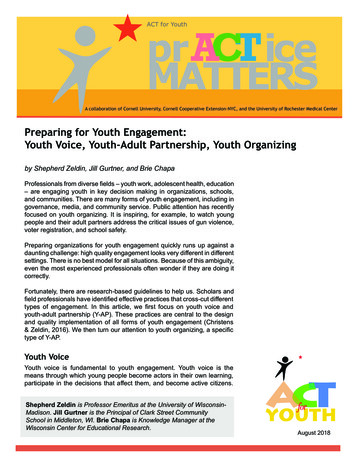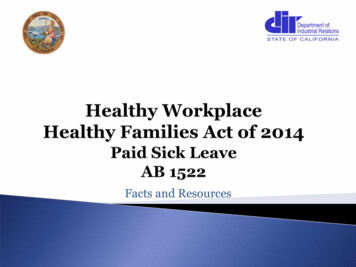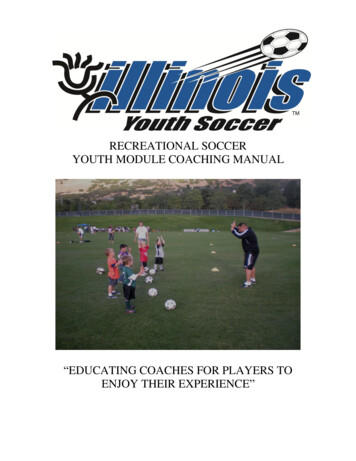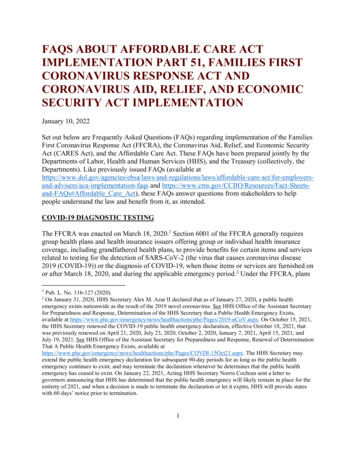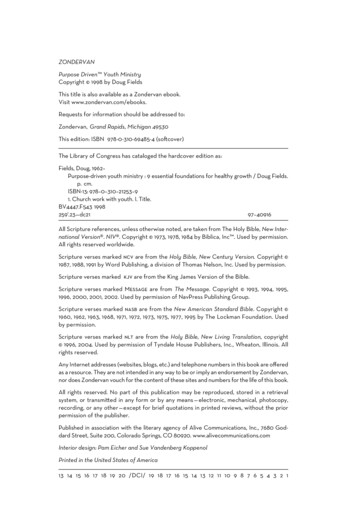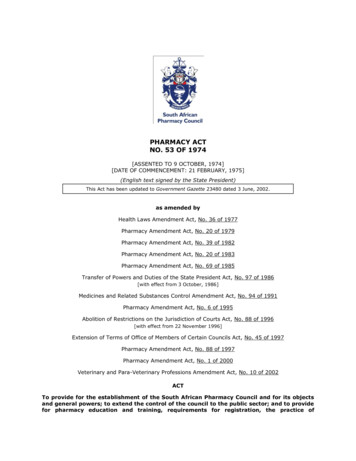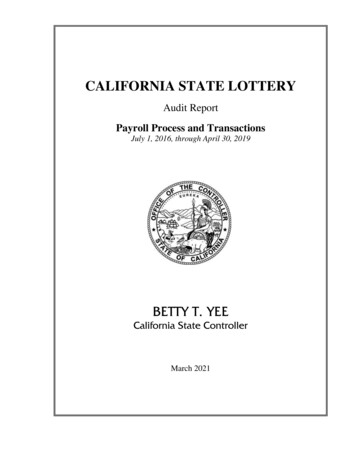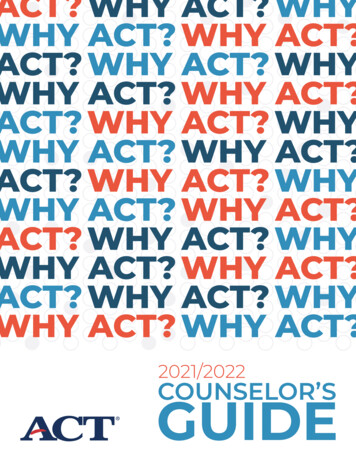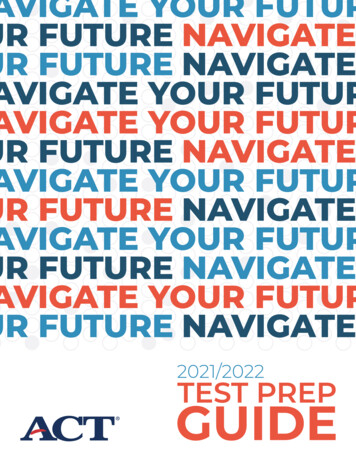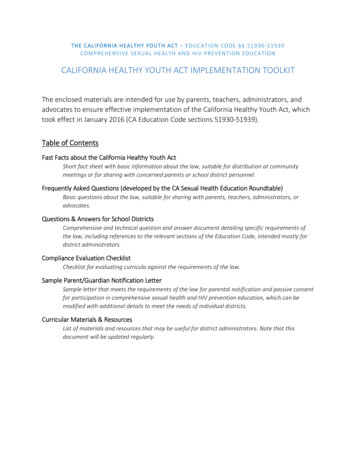
Transcription
THE CALIFORNIA HEALTHY YOUTH ACT – E D U CAT ION CO DE § § 51930 ‐5193 9COMPRE HENSIVE SEXUAL HE AL T H AND HIV PREVEN TI ON EDUCATI ONCALIFORNIA HEALTHY YOUTH ACT IMPLEMENTATION TOOLKITThe enclosed materials are intended for use by parents, teachers, administrators, andadvocates to ensure effective implementation of the California Healthy Youth Act, whichtook effect in January 2016 (CA Education Code sections 51930‐51939).Table of ContentsFast Facts about the California Healthy Youth ActShort fact sheet with basic information about the law, suitable for distribution at communitymeetings or for sharing with concerned parents or school district personnel.Frequently Asked Questions (developed by the CA Sexual Health Education Roundtable)Basic questions about the law, suitable for sharing with parents, teachers, administrators, oradvocates.Questions & Answers for School DistrictsComprehensive and technical question and answer document detailing specific requirements ofthe law, including references to the relevant sections of the Education Code, intended mostly fordistrict administrators.Compliance Evaluation ChecklistChecklist for evaluating curricula against the requirements of the law.Sample Parent/Guardian Notification LetterSample letter that meets the requirements of the law for parental notification and passive consentfor participation in comprehensive sexual health and HIV prevention education, which can bemodified with additional details to meet the needs of individual districts.Curricular Materials & ResourcesList of materials and resources that may be useful for district administrators. Note that thisdocument will be updated regularly.
THE CALIFORNIA HEALTHY YOUTH ACT – E D U CAT ION CO DE § § 51930 ‐5193 9COMPRE HENSIVE SEXUAL HE AL T H AND HIV PREVEN TI ON EDUCATI ONFAST FACTS ABOUT THE CALIFORNIA HEALTHY YOUTH ACTIn January 2016, California adopted a new law covering comprehensive sexual healtheducation and HIV prevention education in public schools, Education Code Sections 51930‐51939 (AB 329). Here are some facts about the law. Comprehensive sexual health and HIV prevention education is required at least once inmiddle school and at least once in high school. Abstinence‐only instruction is notpermitted. All instruction in all grades must be age‐appropriate and medically accurate (meaningaccepted by organizations like the American Academy of Pediatrics) and may not promotereligious doctrine. All elements of the instruction must be in alignment with each other. Sexual health education must respect and address the needs of students of all genders andsexual orientations. Instruction must affirmatively recognize different sexual orientationsand be inclusive of same‐sex relationships when providing examples of couples orrelationships. It must also teach about gender, gender expression, and gender identity, andexplore the harm of negative gender stereotypes. Beginning in grade 7, instruction must include information about the safety andeffectiveness of all FDA‐approved methods of preventing pregnancy and transmission ofHIV and other sexually transmitted infections (including condoms, contraceptives, andantiretroviral treatment) and abstinence. It must also include information about HIV,pregnancy, sexual harassment, sexual assault, healthy relationships, and sex trafficking, aswell as local resources for accessing care and students’ rights to access care. Parents must be notified that their student will receive sexual health and HIV preventioneducation and be allowed to view the materials prior to instruction. Parents/guardians mayremove their student from the instruction by submitting a request in writing. Teachers or outside speakers must have training in and knowledge of the most recentmedically accurate research on the topic. District must also periodically provide training toall district personnel who provide HIV prevention instruction. Outside organizations orspeakers must also follow all laws when they present. Instruction must be appropriate for students with disabilities, English language learners, andstudents of all races and ethnic and cultural backgrounds. Schools must make sure that allstudents can get sexual health education and HIV prevention education in a way that worksfor them.THIS RESOURCE WAS DEVELOPED BY THE ACLU OF CALIFORNIA,A collaboration of the ACLU of Northern California, the ACLU of Southern California, and the ACLU of San Diego & Imperial CountiesFor more information, go to http://www.aclunc.org/sex ed.If you are concerned that your school is not following the law, contact the ACLU for help.
California Healthy Youth Act (CA Education Code Sections 51930‐51939)Frequently Asked QuestionsWhat is the California Healthy Youth Act?The California Healthy Youth Act, which took effect in January 2016, requires school districts to provide studentswith integrated, comprehensive, accurate, and unbiased comprehensive sexual health and HIV preventioneducation at least once in middle school and once in high school.The law is intended to ensure that students develop the knowledge and skills necessary to 1) protect their sexualand reproductive health from HIV, other sexually transmitted infections, and unintended pregnancy; 2) develophealthy attitudes concerning adolescent growth and development, body image, gender, sexual orientation,relationships, marriage, and family; and 3) have healthy, positive, and safe relationships and behaviors. Itpromotes understanding of sexuality as a normal part of human development.Wasn’t comprehensive sexual health education already required?Previously, districts were required to provide only HIV prevention education once in middle school and once inhigh school. Districts that elected to also provide sexual health education were required to do so in a way thatwas comprehensive, medically accurate, and age appropriate.What is different about the new law?In addition to requiring that students receive comprehensive sexual health education at least twice—(at least)once in middle school and (at least) once in high school—the California Healthy Youth Act includes new languageabout adolescent relationship abuse and sex trafficking and reinforces a focus on healthy attitudes, healthybehaviors, and healthy relationships. It also strengthened previous requirements that instruction and materials beappropriate for students of all sexual orientations and genders and ensures that sexual health education does notpromote outdated gender norms. The law also updated the existing HIV prevention education mandate to reflectthe developments made in our understanding of and ability to treat and prevent HIV over the last 20 years.What are the baseline requirements for sexual health education and HIV prevention education?All instruction in all grades (including elementary) must be age‐appropriate, medically accurate, and appropriatefor students with disabilities, students who are English language learners, and for students of all races, ethnic andcultural backgrounds, genders, and sexual orientations. Instruction may not promote religious doctrine.Instruction must affirmatively recognize different sexual orientations, and be inclusive of same‐sex relationshipswhen providing examples of couples or relationships. It must also teach about gender, gender expression, genderidentity, and explore the harm of negative gender stereotypes.Comprehensive sexual health education must encourage students to communicate with their parents or othertrusted adults, and must provide students with the knowledge and skills to develop healthy relationships andmake healthy decisions about sexuality.What are the additional content requirements for grades 7‐12?Instruction provided in grades 7‐12, in addition to meeting the baseline requirements above, must include all ofthe following content: Information on the nature and transmission of HIV and other sexually transmitted infections (STIs);Information about all FDA‐approved methods of reducing the risk of transmission of HIV and other STIs,including antiretroviral treatment, and information about treatment of HIV and STIs;
Information about reducing the risk of HIV transmission as a result of injection drug use by decreasingneedle use and needle sharing;Discussion about social views of HIV and AIDS, emphasizing that all people are at some risk of contractingHIV and that the only way to know one’s HIV status is by being tested;Information about accessing resources for sexual and reproductive health care and assistance with sexualassault and intimate partner violence, as well as students’ legal rights to access these resources;Information about the effectiveness and safety of all FDA‐approved contraceptive methods in preventingpregnancy (including emergency contraception);Information that abstinence is the only certain way to prevent unintended pregnancy and HIV and otherSTIs; information about value of delaying sexual activity must be included and must be accompanied byinformation about other methods for preventing pregnancy and STIs;Information about pregnancy, including 1) the importance of prenatal care; 2) all legally availablepregnancy outcomes, including parenting, adoption, and abortion; and 3) California’s newborn safesurrender law;Information about sexual harassment, sexual assault, adolescent relationship abuse, intimate partnerviolence, and sex trafficking.Does the law allow abstinence‐only education?“Abstinence‐only” sex education, which offers abstinence as the only option for preventing STIs and unintendedpregnancy, is not permitted in California public schools.What does the law say about parental notification and consent?Districts must notify parents of the instruction and provide them with opportunities to view the curriculum andother instructional materials. Districts must also allow parents to remove their student from instruction if they sochoose, using a passive consent (“opt‐out”) process in which parents must request in writing that their studentnot receive the instruction. Districts may not require active consent (“opt‐in”) by requiring that students return apermission slip in order to receive the instruction.How can I ensure that my district is complying with the new law?The California Healthy Youth Act took effect on January 1, 2016, and districts should be taking steps now toensure compliance. Districts need to ensure that their board policies, parental notification forms, and curricula allcomply with the requirements of the law.The ACLU of California has created additional implementation resources for school districts, including fact sheets,a sample parent notification letter, a curriculum checklist, and information about curricular resources. You canaccess these materials at www.aclunc.org/sex ed.How do districts ensure that teachers are prepared to deliver this instruction?Districts must provide in‐service training for all teachers who provide HIV prevention education and may expandthat training to cover the topic of comprehensive sexual health education.Can my district contract with an outside consultant to provide this instruction?School districts may contract with outside consultants or guest speakers to deliver instruction or to providetraining for school district personnel. All outside consultants and guest speakers must have expertise incomprehensive sexual health education and HIV prevention education and have knowledge of the most recentmedically accurate research on the relevant topic or topics covered in their instruction. Instruction provided byoutside consultants or guest speakers meet all of the law’s requirements and must be aligned with otherinstruction.The California Sexual Health Education Roundtable is convened by:ACLU of Northern California, California Latinas for Reproductive Justice, and Planned Parenthood Affiliates of California
THE CALIFORNIA HEALTHY YOUTH ACT: EDUCATION CODE §§ 51930 –51939QUESTIONS & ANSWERS FOR SCHOOL DISTRICTSTHE CALIFORNIA HEALTHY YOUTH ACT – E DU CAT ION CODE § § 51930 -5193 9COMP RE HENSI VE SEX UA L HE AL T H A ND HIV PREVEN TI ON EDU CATI ONQUESTIONS & ANSWERS FOR SCHOOL DISTRICTSThe California Healthy Youth Act, which took effect January 1, 2016, requires school districts to providestudents with integrated, comprehensive, accurate, and inclusive comprehensive sexual health educationand HIV prevention education, at least once in high school and once in middle school. The California HealthyYouth Act made other significant changes to previous Education Code requirements for both HIVprevention education and comprehensive sexual health education.WHAT ARE THE PURPOSES THE CALIFORNIA HEALTHY YOUTH ACT?The California Healthy Youth Act has several purposes (EC § 51930(b)): To provide students with the knowledge and skills necessary to:o Protect their sexual and reproductive health from HIV and other sexually transmittedinfections and from unintended pregnancy;o Develop healthy attitudes concerning adolescent growth and development, bodyimage, gender, sexual orientation, relationships, marriage, and family;o Have healthy, positive, and safe relationships and behaviors;To promote understanding of sexuality as a normal part of human development; andTo ensure pupils receive integrated, comprehensive, accurate, and unbiased sexual health andHIV prevention instruction and provide educators with clear tools and guidance to accomplishthat end.ARE SCHOOLS REQUIRED TO TEACH COMPREHENSIVE SEXUAL HEALTH EDUCATIONAND HIV PREVENTION EDUCATION?Yes. The California Healthy Youth Act requires that that students in grades 7-12 receive comprehensivesexual health education and HIV prevention education at least once in middle school and once in highschool. The Education Code defines comprehensive sexual health education as “education regardinghuman development and sexuality, including education on pregnancy, contraception, and sexuallytransmitted infections” (EC § 51931(b)) and HIV prevention education as “instruction on the nature ofhuman immunodeficiency virus (HIV) and AIDS, methods of transmission, strategies to reduce the risk ofHIV infection, and social and public health issues related to HIV and AIDS” (EC § 51931(d)). HIV preventioneducation has been mandated since 1992.DOES THE LAW PERMIT SCHOOLS TO TEACH COM PREHENSIVE SEXUAL HE ALTH AND HIVPREVENTION EDUCATION IN ELEMENTARY SCHOOL ?Yes. Comprehensive sexual health and HIV prevention education may be taught in grades K-6, inclusive. Allinstruction and materials in grades K-6 must meet the baseline requirements listed below. Content that is1
THE CALIFORNIA HEALTHY YOUTH ACT: EDUCATION CODE §§ 51930 –51939QUESTIONS & ANSWERS FOR SCHOOL DISTRICTSrequired in grades 7-12 may be also be included in an age-appropriate way in earlier grades. (EC §§ 51933,51934(b).)WHAT ARE THE BASELINE REQUIREMENTS FOR ALL COMPREHENSIVE SEXUAL HEALTHEDUCATION AND HIV PREVENTION EDUCATION?According to the Education Code (EC § 51933), all instruction and materials in all grades (includingelementary) must: Be age-appropriate;Be medically accurate and objective;Align with and support the purposes of the California Healthy Youth Act, as described above;Be appropriate for use with pupils of all races, genders, sexual orientations, ethnic and culturalbackgrounds;Be appropriate for and equally available to English language learners;Be appropriate for and accessible to pupils with disabilities;Affirmatively recognize different sexual orientations and be inclusive of same-sex relationshipsin discussions and examples;Teach about gender, gender expression, gender identity, and the harm of negative genderstereotypes;Encourage students to communicate with their parents/guardians and other trusted adultsabout human sexuality, and provide skills for doing so;Teach respect and skills for committed relationships such as marriage;Provide knowledge and skills for forming healthy relationships that are free from violence; andProvide knowledge and skills for making and implementing healthy decisions about sexuality.In addition, the Education Code (EC § 51933) specifies that instruction and materials in all grades may not: Teach or promote religious doctrine; orReflect or promote bias against any person on the basis of actual or perceived disability,gender, gender identity, gender expression, race or ethnicity, nationality, religion, or sexualorientation, or any other category protected by the non-discrimination policy codified inEducation Code § 220.WHAT ADDITIONAL CONTENT IS REQUIRED IN GRADES 7 -12?Instruction provided in grades 7-12, in addition to meeting the baseline requirements above, must includeall of the following content (EC § 51934): Information on the nature and transmission of HIV and other sexually transmitted infections(STIs);2
THE CALIFORNIA HEALTHY YOUTH ACT: EDUCATION CODE §§ 51930 –51939QUESTIONS & ANSWERS FOR SCHOOL DISTRICTS Information about all federal Food and Drug Administration (FDA)-approved methods ofreducing the risk of transmission of HIV and other STIs, including antiretroviral treatment, andinformation about treatment of HIV and STIs;Information about reducing the risk of HIV transmission as a result of injection drug use bydecreasing needle use and needle sharing;Discussion about social views of HIV and AIDS, emphasizing that all people are at some risk ofcontracting HIV and that the only way to know one’s HIV status is by being tested;Information about accessing resources for sexual and reproductive health care and assistancewith sexual assault and intimate partner violence, as well as students’ legal rights to accessthese resources;Information about the effectiveness and safety of all federal FDA-approved contraceptivemethods in preventing pregnancy (including emergency contraception);Information that abstinence is the only certain way to prevent unintended pregnancy and HIVand other STIs; information about value of delaying sexual activity must be included and mustbe accompanied by information about other methods for preventing pregnancy and STIs;Information about pregnancy, including 1) the importance of prenatal care; 2) all legallyavailable pregnancy outcomes, including parenting, adoption, and abortion; and 3) California’snewborn safe surrender law; andInformation about sexual harassment, sexual assault, adolescent relationship abuse, intimatepartner violence, and sex trafficking.See EC § 51934 for the exact language of these requirements.Any of these content areas may also be covered in an age-appropriate way prior to grade 7.DOES THE LAW ALLOW ABSTINENCE -ONLY EDUCATION?No. “Abstinence-only” sex education, which offers abstinence as the only option for preventing STIs andunintended pregnancy, is not permitted in California public schools.Comprehensive sexual health education in grades 7-12 must include medically accurate, up-to-dateinformation about the effectiveness and safety of all federal FDA-approved methods for preventing HIV,other STIs, and pregnancy. (EC § 51934(a)(9).)In addition, abstinence may not be discussed in isolation from other methods of preventing HIV, other STIs,and pregnancy. The Education Code requires that instruction and materials include information thatabstinence is the only certain way to prevent HIV, other STIs, and unintended pregnancy. However, it alsostates: “Instruction shall provide information about the value of delaying sexual activity while also providingmedically accurate information on other methods of preventing HIV and other sexually transmittedinfections and pregnancy.” (EC § 51934(a)(3).)3
THE CALIFORNIA HEALTHY YOUTH ACT: EDUCATION CODE §§ 51930 –51939QUESTIONS & ANSWERS FOR SCHOOL DISTRICTSWHY IS THERE A REQUIREMENT FOR INTEGRATED INSTRUCTION, AND WHAT DOES ITMEAN?In order to ensure that students receive instruction that best supports their need for accurate,comprehensive information, the requirement for integrated instruction means that there must be internalconsistency within sexual health education and HIV prevention instruction and materials. All instructionand materials must support and align with the purposes of the California Healthy Youth Act and with eachother; they may not be in conflict with or undermine each other or any of the purposes of the law. Forexample, schools may not use materials that, in promoting abstinence, focus exclusively on the failure ratesor perceived disadvantages of condoms or contraception, even if schools attempt to balance thesematerials with other, objective information. (EC §§ 51930(b)(4), 51933(c).)HOW DOES THE LAW PROMOTE HEALTHY RELATIONSHIPS FOR YOUTH?The California Healthy Youth Act has a strong emphasis on healthy relationships, in both the purposes andthe required content. Students must be taught knowledge and skills related to recognizing, building, andmaintaining healthy relationships that are based on mutual affection and are free from violence, coercionand intimidation. This includes teaching decision-making and communication skills and helping students tounderstand the value of and prepare for committed relationships, such as marriage. It also includesinformation about unhealthy behaviors and risks to their health, such as sexual harassment, sexual assault,intimate partner violence, and sex trafficking. (EC §§ 51930(b); 51933(f), (g), (h); 51934(a)(10).)DOES THE LAW REQUIRE INSTRUCTION ABOUT LOCAL HEALTH RESOURCES?Yes. The California Healthy Youth Act requires that students learn about local resources for sexual andreproductive health care, sexual assault and intimate partner violence. The law also requires instructionabout how students can access those resources and their rights to access them. For example, underCalifornia law, minors aged 12 and above have the right to confidentially access and make their owndecisions regarding reproductive health care, including birth control, prenatal care, abortion, andprevention of and treatment for HIV and STIs. (Family Code §§ 6925, 6926; American Academy of Pediatricsv. Lungren, 16 Cal.4th 307 (1997)). Students also have the right to obtain sensitive services, includingreproductive health care, during school hours, and must be allowed to leave campus for the purpose ofobtaining these services. (EC § 48205; EC § 46010.1; 87 Ops. Cal. Atty. Gen. 168, 172 (2004)). In theseinstances, schools are not allowed to require parental consent or notification, and must mark the student’sabsence as excused and allow the student to make up full credit for assignments or class time missed.DOES THE LAW REQUIRE INSTRUCTION ON CALIFORNIA’S AFFIRMATIVE CONSENTSTANDARD?Another law, distinct from the California Healthy Youth Act, also took effect in 2016. This law, EducationCode § 33544, requires that all school districts that have health education as a graduation requirementmust include instruction on California’s affirmative consent standard. This standard is defined as follows:“‘Affirmative consent’ means affirmative, conscious, and voluntary agreement to engage in sexual activity.It is the responsibility of each person involved in the sexual activity to ensure that he or she has the4
THE CALIFORNIA HEALTHY YOUTH ACT: EDUCATION CODE §§ 51930 –51939QUESTIONS & ANSWERS FOR SCHOOL DISTRICTSaffirmative consent of the other or others to engage in the sexual activity. Lack of protest or resistancedoes not mean consent, nor does silence mean consent. Affirmative consent must be ongoing throughouta sexual activity and can be revoked at any time. The existence of a dating relationship between the personsinvolved, or the fact of past sexual relations between them, should never by itself be assumed to be anindicator of consent.” (EC § 67386.)Instruction on the affirmative consent standard is not mandatory for districts that do not require a healtheducation course for graduation. The law also does not require that this instruction be provided withincomprehensive sexual health and HIV prevention education. However, the California Healthy Youth Actdoes require that comprehensive sexual health education and HIV prevention education address healthyrelationships and communication, and consent for sexual activity is an important component of thisinstruction. Therefore, there is natural overlap between the law relating to the affirmative consent standardand the California Healthy Youth Act.WHAT DETERMINES WHETHER THE FACTS TAUGHT ARE MEDICALLY ACCURATE?Instruction is medically accurate if it is verified or supported by proper scientific research, published inpeer-reviewed journals as appropriate, and recognized as accurate and objective by agencies with expertisein the field, such as the federal Centers for Disease Control and Prevention (CDC), the American PublicHealth Association, the American Academy of Pediatrics, and the American College of Obstetricians andGynecologists. (EC § 51931(f).)WHAT DOES THE LAW SAY ABOUT LESBIAN, GAY, BISEXUAL, TRANSGENDER ANDQUEER (LGBTQ) ST UDENTS, SEXUAL ORIENTATION, AND GENDER/GENDER IDENTITY?All instruction and materials in grades K-12 must be inclusive of LGBTQ students. Instruction shallaffirmatively recognize that people have different sexual orientations and, when discussing or providingexamples of relationships and couples, must be inclusive of same-sex relationships. (EC § 51933(d)(5).) Itmust also teach students about gender, gender expression, gender identity, and explore the harm ofnegative gender stereotypes. (EC § 51933(d)(6).) This means that schools must teach about sexualorientation and what being transgender means.The California Healthy Youth Act requires that sexual health education be appropriate for use with studentsof all genders and sexual orientations and clearly states that part of the intent of the law is “to encouragea pupil to develop healthy attitudes concerning adolescent growth and development, body image, gender,sexual orientation, relationships, marriage, and family.” (EC § 51930.)The California Healthy Youth Act also prohibits sexual health education classes from promoting bias againstanyone on the basis of any category protected by Education Code § 220, which includes actual or perceivedgender and sexual orientation.5
THE CALIFORNIA HEALTHY YOUTH ACT: EDUCATION CODE §§ 51930 –51939QUESTIONS & ANSWERS FOR SCHOOL DISTRICTSWHAT DOES THE LAW SAY ABOUT STUDENTS WITH DISABILITIES?Instruction and materials must be appropriate for and accessible to students with disabilities. This includesbut is not limited to providing a modified curriculum, materials and instruction in alternative formats, andauxiliary aids. (EC § 51933(d)(3).)WHAT DOES THE LAW SAY ABOUT STUDENTS WHO ARE ENGLISH LEARNERS?The California Healthy Youth Act requires that instruction be made available on an equal basis to pupilswho are English learners, whether they are placed in English immersion classes or alternative bilingualeducation classes, and must be consistent with the existing sex education curriculum. (EC § 51933(d)(2).)In addition, the law requires that instruction be appropriate for use with students of all races and ethnicand cultural backgrounds. (EC § 51933(d)(1).)DOES THE LAW PERMIT THE USE OF OUTSIDE SPEAKERS?School districts may contract with outside consultants or guest speakers, including those who havedeveloped multilingual curricula or curricula accessible to persons with disabilities, to delivercomprehensive sexual health education and HIV prevention education or to provide training for schooldistrict personnel. All outside consultants and guest speakers must have expertise in comprehensive sexualhealth education and HIV prevention education and have knowledge of the most recent medically accurateresearch on the relevant topic or topics covered in their instruction. (EC § 51936.)Instruction provided by outside consultants or guest speakers must fulfill the same requirements asinstruction provided by employees of the school district. This instruction must be integrated into and maynot conflict with other instruction or with the purposes of the law. If schools use outside consultants orguest speakers, they must provide parents with the name of the provider’s organization and the date ofinstruction at the beginning of the school year or no fewer than 14 days prior to the date of instruction.HOW DOES THE LAW SUPPORT FAMILY COMMUNICATION ABOUT COMPREHENSIVESEXUAL HEALTH?Instruction and materials shall encourage a student “to communicate with his or her parents, guardians,and other trusted adults about human sexuality and provide the knowledge and skills necessary to do so.”(EC § 51933(e).)WHAT DOES THE LAW SAY ABOUT PARENT/GUARDIAN NOTIFICATION AND CONSENTFOR INSTRUCTION?Parents or guardians must be notified by the school or district at the beginning of the school year (or at thetime of enrollment) about planned comprehensive sexual health and HIV prevention education, and mustbe given an opportunity to review materials. The school district must also inform parents/guardians aboutwhether the instruction will be provided by district personnel or outside consultants. If instruction will be6
THE CALIFORNIA HEALTHY YOUTH ACT: EDUCATION CODE §§ 51930 –51939QUESTIONS & ANSWERS FOR SCHOOL DISTRICTSprovided by outside consultants, the notice must include the name and organizational affiliation of theoutside consultant and the date of the instruction. The notice must also inform parents/guardians of theirright to request copies of Education Code §§ 51933, 51934, and 51938. If arrangements for guest speakersor outside consultants are made after the initial notification is sent out at the beginning of the year, districtsmust notify parents at least 14 days prior to the instruction via mail or another commonly used method.The law allows parents or guardians to remove their child from comprehensive sexual health and HIVprevention education, as defined in the statute (EC §§ 51931(b), (d), 51932.), using a passive consent or“opt-out” process. Schools may not requ
QUESTIONS & ANSWERS FOR SCHOOL DISTRICTS 1 THE CALIFORNIA HEALTHY YOUTH ACT - EDUCATION CODE §§ 51930-51939 COMPREHENSIVE SEXUAL HEALTH AND HIV PREVENTION EDUCATION QUESTIONS & ANSWERS FOR SCHOOL DISTRICTS The California Healthy Youth Act, which took effect January 1, 2016, requires school districts to provide
